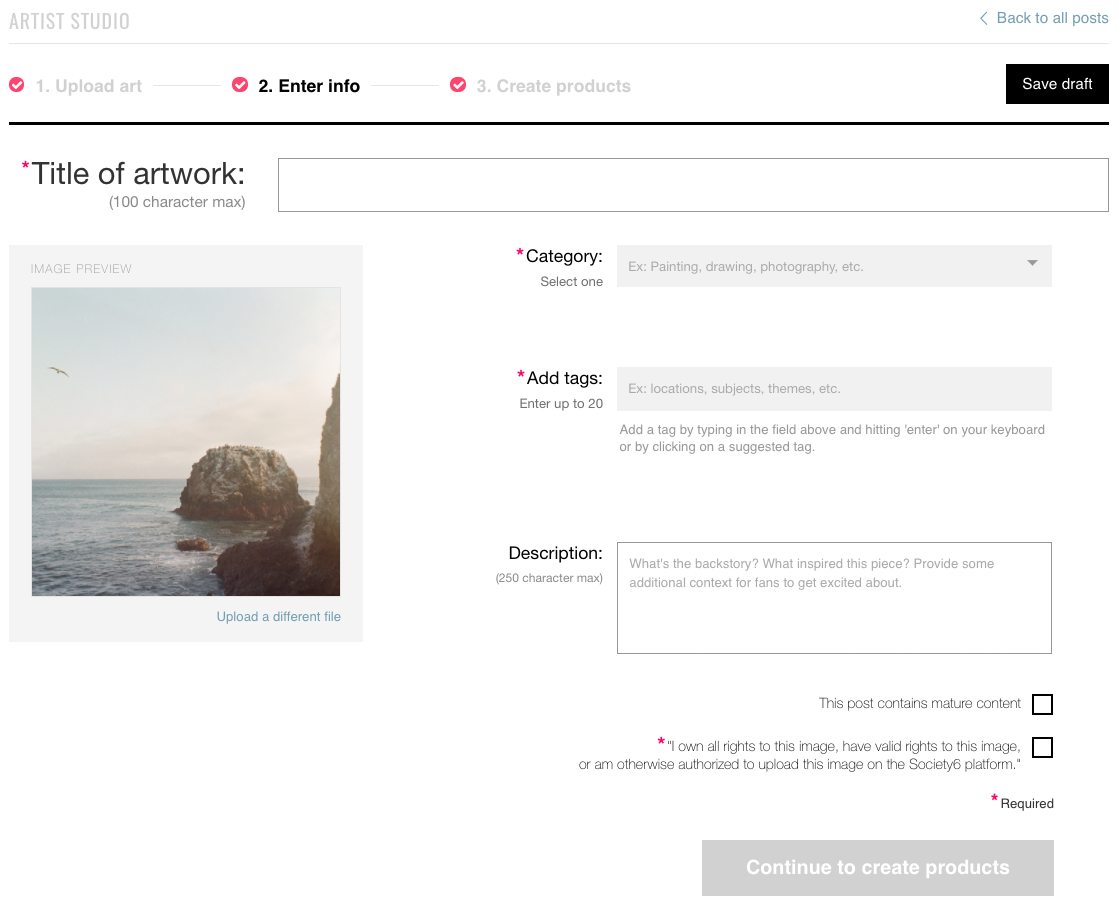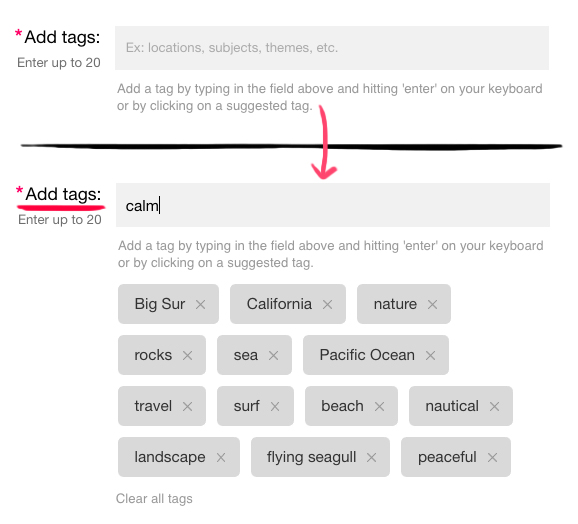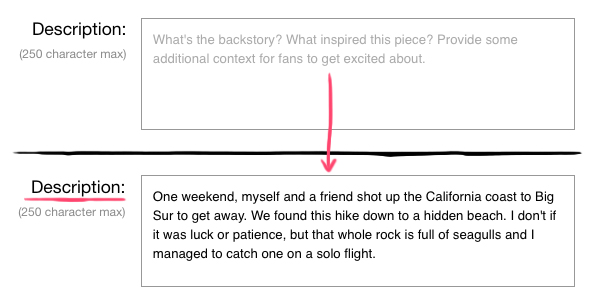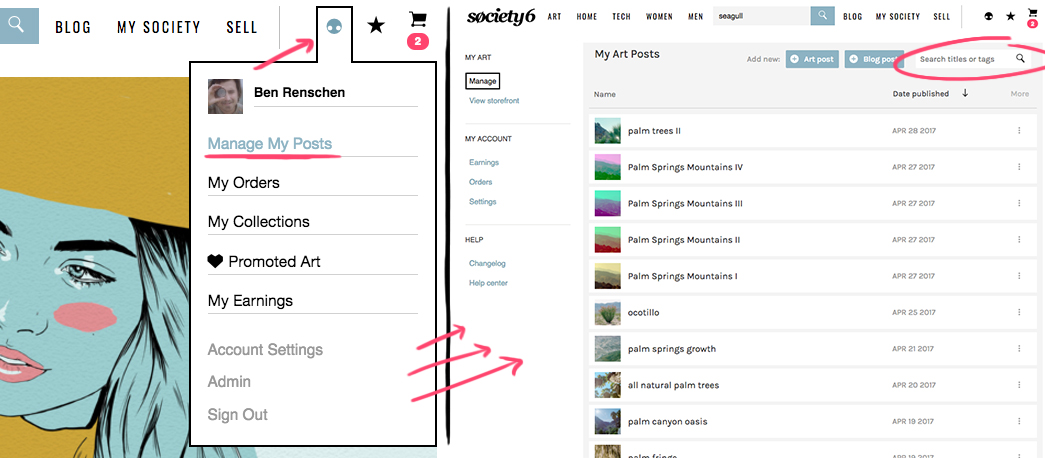Once you’ve uploaded your artwork, you’ll want to make sure it can be found. We’re going to show you how.
With tagging and description fields built seamlessly into Society6’s upload process, you’re in total control of your own discoverability–and it starts with high-quality metadata. In this article, you’ll learn what metadata is, why you need to avoid “keyword stuffing” and why relevant metadata is a make or a break for your artwork.
Before we get into making your artwork discoverable, let’s make sure YOU are discoverable by name first. Whether you want to appear in search results on Society6 or other search engines like Google, be certain the spelling of your name in your Account Settings is accurate. If customer’s can’t search for you by name, there’s a good chance you’re missing sales. It happens more than you think!

1 | What is metadata?
Metadata is data or information that describes other data (i.e. your artwork). Time spent providing quality metadata is as important, if not more, than getting the artwork uploaded all together. This is the part of the process that allows people to actually find your artwork.
Metadata for your artwork:
- Title
- Tags
- Description
PRO TIP: Your Display Name and About page are also examples of metadata you have control over. Make sure to fill those out for the best chance to be found in search.
2 | The best metadata is relevant metadata
Search engines use a process called “indexing” to record the information you’ve appended to your artwork via title, tags and description. Because an image (i.e. your artwork) isn’t “descriptive” of itself, sites like Society6, Google and other search engines rely on you to provide that info. When a customer searches for something similar to your artwork on any search engine, they’re actually searching the metadata you provided. So, if you don’t provide relevant metadata, it’s highly unlikely you’ll show up in search results anywhere.
3 | This is what matters when adding Titles, Tags and Descriptions
First, think like your customers. When looking at your artwork, what would they be searching for. Titles, Tags and Descriptions are all considered simultaneously when a customer enters a search term or phrase. Adding relevant metadata in each of these sections increases your chance to show up in front of customers. Further, on Society6 specifically, we consider sales and promotions when serving up search results as well. Knowing all that, let’s use this photo I took in Big Sur (below) as an example.
TITLE: The best title for your artwork is one that reflects the subject of your artwork
The closer your title is to what someone is searching for, the more likely you’ll show up in search results. If I named the above piece “Flying Solo” and didn’t add “Big Sur” into the description or tags, anyone searching for “Big Sur Wall Tapestries” would likely never find it–on Society6 or otherwise. However, with the title “A Break From the Pack in Big Sur”, I show up on the first page of results.

TAGS: The best tags for your artwork are relevant ones
Think like your customer. What are the words they would actually type in to discover your work? Tag themes, mediums, location and any specifics seen in your artwork. Take it from some top-sellers…
“Include broad terms that get at the theme of the piece (I’ll often include “witch” and “occult” for all of my magical looking artworks) as well as specifics (I might name specific items pictured like crystal ball, snake, tarot card, rune stones, etc).” – Camille Chew aka Lord of Masks
“I tag based on place, style, feeling, etc. For a forest design I would use tags like: tree, forest, woods, wilderness, adventure, wanderlust, explore, Oregon, hike, camp, outdoors, pine tree, northwest, etc. Since I generally use similar tags for many of my designs I have a word document saved so I can essentially copy and paste my tags with a few minor tweaks!” – Leah Flores

Overall, the more relevant your tags, the more likely a customer is to discover your artwork. It’s a numbers game at that point. The more eyes on your work, the greater the chance of a sale. The further away you get from relevant tags, the less likely a customer is going to purchase because it’s just not what they’re looking for.
DESCRIPTION: The best description for your artwork is something interesting about it
Aside from providing valuable metadata for search engines to know what your artwork is about, by giving your customers the opportunity to become knowledgeable in your artwork, you encourage them to give you real-life promotions. You allow customers to become passionate champions of your work.
Think of the person who has already bought your artwork on a new iPhone Case. When that customer talks about their phone case (which goes everywhere), they have something unique to share regarding your work. Whoever is listening is more likely to find themselves at your shop because they already have a sense of your work.

4 | Optimize or update your best selling artwork!
For your best-selling artwork and anything uploaded before October 2016, we highly recommend going back and updating with relevant tags and descriptions. If you’ve been on the site for a while, there’s a chance you’re using our outdated description field for tagging, which means you could be missing out on sales. This could give you a surprise bump, but more importantly, makes sure you have the best chance to be seen.
UPDATING PREVIOUSLY UPLOADED ARTWORK


5 | Finally, avoid “keyword stuffing” at all costs
As if I haven’t driven home the importance of “relevant” metadata enough yet, “keyword stuffing” will get you penalized. If you try to hack your way into getting discovered by jamming a bunch of irrelevant info into your titles, tags and descriptions, search engines recognize this tactic in their algorithms and keep your artwork lower, or completely out of search results. That’s the exact opposite of what you want.
“Definitely be straight-forward and clear in the tags so people are led to your piece for the right reasons.” –Robin Eisenberg
Again, you should be adding metadata that is relevant. The last thing you want to do is give customers a reason to avoid you!
All in all, spending the time to append quality metadata to your artwork is not only important for your discovery on Society6, but across the internet. We get millions of monthly visitors from all over the world looking for one of a kind products. Ideally, they’re looking for your products and quickly find them.

Comments